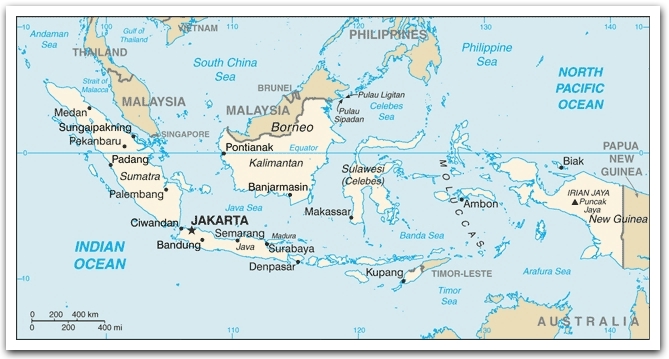

Indonesia :: Geography

|
Capital city: Jakarta
The bright orange and noisy bajaj (a motorized autorickshaw) is a common mode of public transportation in Jakarta. It seats two passengers comfortably in the back. Its area of operation is limited to a mayoralty, indicated in a circle on the side of the driver's door. The bajaj is also not allowed onto many major roads.Location: Southeastern Asia, archipelago between the Indian Ocean and the Pacific Ocean
The world's largest archipelago with some 17,000 islands of which 6,000 are inhabited. The islands are divided into 3 groups:Area: 1,919,440 sq km - Indonesia is the largest country in Southeast Asia.
- Greater Sunda Islands (including Sumatra, Kalimantan, Sulawesi and Java)
Orangutans are an endangered species of great apes found in the wild on the islands of Sumatra and Borneo (which include the Kalimantan province of Indonesia). They have long arms and reddish brown hair.- Lesser Sunda Islands (in the southeast, near Timor-Leste)
Located near the Lesser Sunda Islands is the Komodo National Park which includes the three larger islands Komodo, Rinca and Padar, as well as numerous smaller ones. These volcanic islands are inhabited by giant lizards called 'Komodo dragons' which can grow up to 3m long. Their saliva contains a host of bacteria and toxins. A buffalo or a deer scratched by the teeth of the komodo, can die the following day.- Moluccas (aka Maluku)
- Irian Jaya, a part of New Guinea, is also included in Indonesia.
(land: 1,826,440 sq km; water: 93,000 sq km)
Terrain: mostly coastal lowlands; larger islands have interior mountains
Elevation extremes
lowest point: Indian Ocean 0 m;
highest point: Puncak Jaya
Largest lake: Toba, 1,145 sq km
Major rivers: Barito, Kapuas, Mahakam
Land use
arable land: 11.03%;
permanent crops: 7.04%;
other: 81.93% (2005)
Irrigated land: 45,000 sq km (2003)
Natural resources: petroleum, tin, natural gas, nickel, timber, bauxite, copper, fertile soils, coal, gold, silver
Climate: tropical; hot, humid; more moderate in highlands
Natural hazards: occasional floods, severe droughts, tsunamis, earthquakes, volcanoes, forest fires
Environment issues: (1) deforestation; (2) water pollution from industrial wastes, sewage; (3) air pollution in urban areas; (4) smoke and haze from forest fires